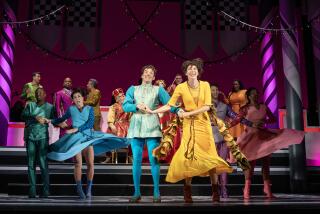Rockin’ till it’s scarlet in the face
- Share via
Puritans breaking into power ballads makes heady sense in Mark Governor’s rock musical “shAme,” adapted from Nathaniel Hawthorne’s “The Scarlet Letter.” And not just because opposites -- in this case, repression and rock music -- attract. The story of Hester Prynne’s adultery and condemnation by shrilly pious Bostonians in 1642 has the fevered delirium of a classic rock album. The uneven but vivid inaugural production of the Los Angeles Rock Opera Company, “shAme” now pumps up the volume of this classic pageant on Wednesdays at King King in Hollywood.
“Letter” was an instant bestseller in 1850 and became one of the first American books to be mass-produced. The story had an irresistible hook: A beautiful young woman, her husband missing and presumed dead, gives birth to a daughter and refuses to name the father. She’s defended from intense scorn by the eloquent Rev. Arthur Dimmesdale, who is, of course, her lover.
Director-choreographer Janet Roston uses King King’s grunge-chic club space, with its exposed brick and steel beams, to set an aesthetic that emphasizes raw performance. A screen flashes images that reflect story locations (churches, forests) and contemporary resonance (when the town gossips about Hester, we see clips from confessional chat shows). The projections can be heavy-handed, and you feel the production doesn’t entirely trust its ability to sustain an audience’s attention by song alone. Leah Piehl’s costumes are the show’s visual center, and she keeps her palette black, white and gray.
The show gets off to a rocky start: The ensemble struggles with microphone volume and feedback, and Governor’s efforts to set up the world of the novel are a little sophomoric (“You wore the same clothes every day!” “Before cellphones . . . “ “No one talked about s-e-x.”). After a few numbers, however, “shAme” settles into itself, and the sung-through score uses styles including doo-wop, tango and Zeppelinesque wail.
Katrina Lenk’s haunted, sensuous Hester has a beautifully clear voice. Dr. Roger Chillingworth, Hester’s long-lost husband who hides his true identity to insinuate himself into Dimmesdale’s life, is re-imagined as a kind of Thunderdome bully. Danny Shorago goes way over the top in the role, but he powers the show almost single-handedly.
As Dimmesdale, Mark Luna doesn’t quite communicate the crippling inner turmoil of Hester’s forbidden love. Yet Shorago and Luna share one of the show’s most affecting songs, “Interior of a Heart,” in which the man of science and the man of faith acknowledge the limits of their disciplines in illuminating the paradoxes of love.
Despite its flaws and excesses, “shAme” accumulates a certain blunt power. In the final scene, where the titular letter has transmuted from a symbol of adultery into one of enduring integrity, alchemy has taken place. Governor liberates that capital A from its burden of literary respectability; it’s never a bad thing to hand a masterpiece a mike and let it belt one.
More to Read
The biggest entertainment stories
Get our big stories about Hollywood, film, television, music, arts, culture and more right in your inbox as soon as they publish.
You may occasionally receive promotional content from the Los Angeles Times.










